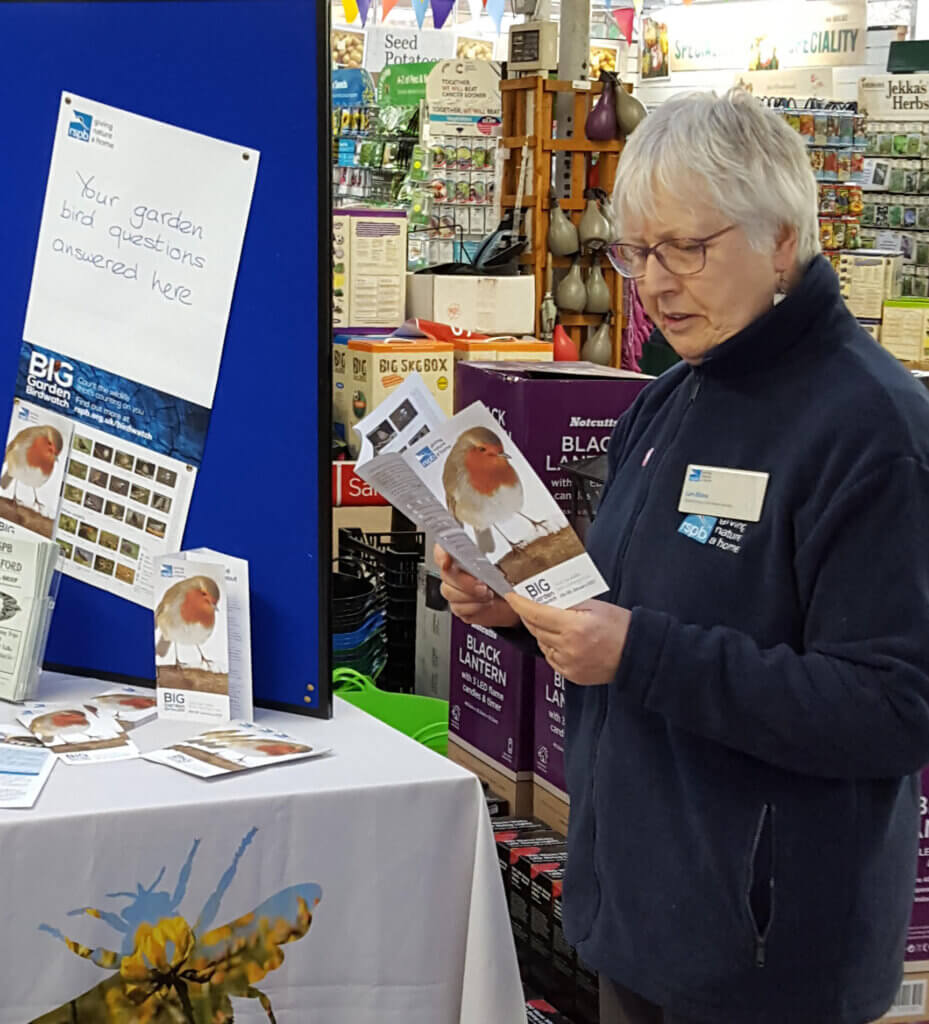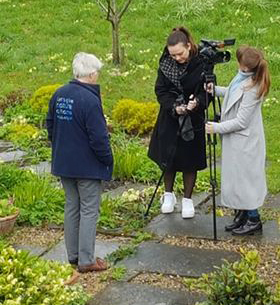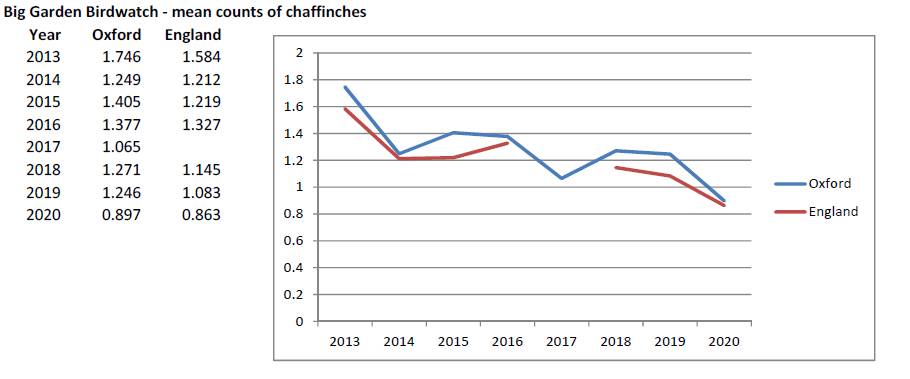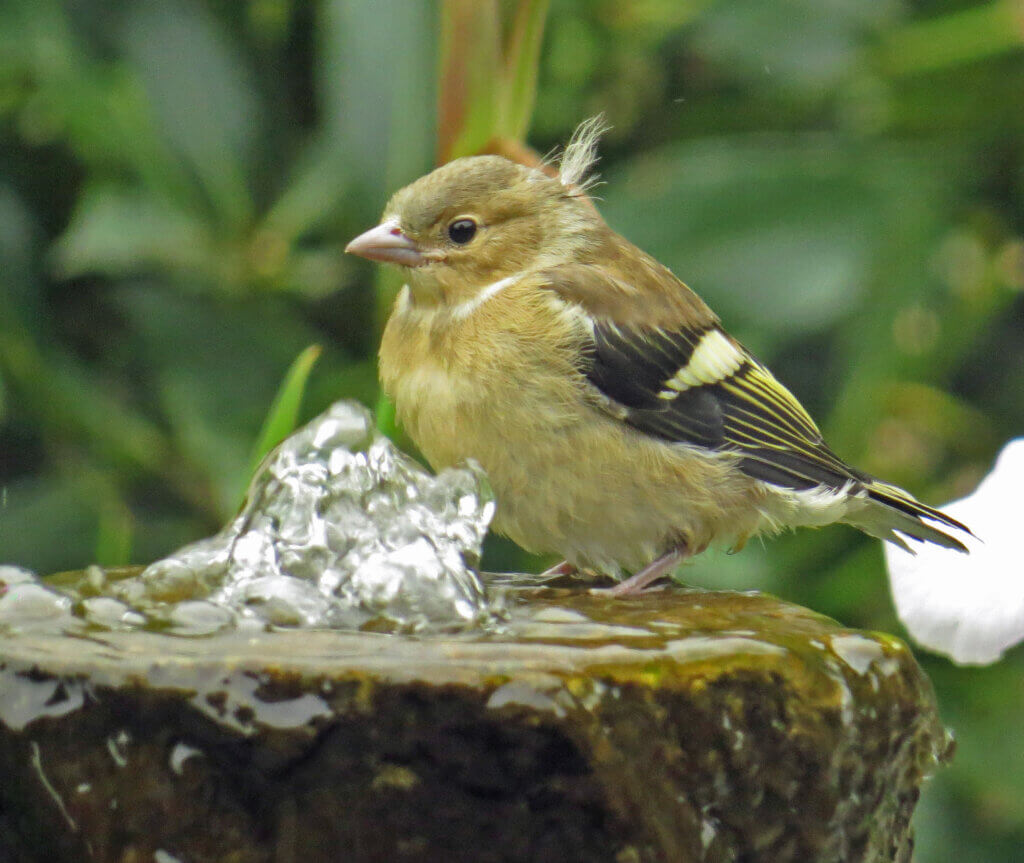
Lyn Ebbs is a scientist by education and has been a member of the RSPB for many years and volunteered for them since she retired. Lyn is actively involved with wildlife campaigns and has attended Hen Harrier Day rallies every year since joining the Sodden 570. Lyn has written three accounts of RSPB AGMs here (one on the 2019 AGM, others on the 2016 RSPB AGM and 2015 RSPB AGM) and a book review and is a regular commenter.

I write the newsletter for my RSPB local group, and am usually on the lookout for topics to write on. The Big Garden Birdwatch is always good copy – publicising it in January and discussing the results in April. As well as the headline figures on the RSPB website, there is usually a spreadsheet which allows you to filter out your local results (scroll right to the bottom of the page to the last line: Full Results). I’ve made it my mission for some years to digest the Oxfordshire results in some detail so I have quite a lot of old BGBW results on file. I’ve even discussed the Oxford results on a local YouTube channel.
When Mark made some disparaging remarks about the BTO’s appeal based on declining chaffinch numbers and with some time on my hands (who hasn’t?) I thought I would see if I had enough data from BGBW to verify the claim of decline. It wasn’t exactly a huge dataset, my files only went back to 2013 and one year I hadn’t saved the full results, only the Oxford-specific ones. I didn’t have full UK results for every year but, based on Mark’s opinion that most chaffinches live in England, only including data for England seemed relevant. For what it’s worth, here are the figures I extracted from the results and the accompanying graph:

Perhaps someone from the RSPB who has access to the full BGBW dataset could do a proper job on this.
Purely anecdotally, I don’t think Richard and I were seeing as many chaffinches in our own garden, so it was good to have that confirmed. We have entertained young ones in the past:
And with two pairs still visiting we hope to see young again this year.

Please be kind in the comments, I’m not a statistician, just an ageing scientist trying to avoid doing only housework to pass the time in lockdown.
[registration_form]
Brilliant Lyn, very useful data. We too have noticed a decline in Chaffinch numbers in our garden in south Oxfordshire. Why that should be I think remains to be properly sussed out. I hope it is not a disease similar to what caused to decline of greenfinches.
Pleased to say that in our area south Oxfordshire greenfinch numbers seem to be slowly recovering.
I think it is important to regularly disinfect bird feeders and any patch on the ground where birds regularly feed from spillage. I find the disinfectant spray that can be purchased on line from the RSPB very good. It is specially produced for birds and small animals and I spray my feeders and the ground below them with it two or three times a week. I think it makes a difference.
No great decline in my garden in Cheshire. Still practically zero. I think I remember — over sixty years ago it must be — reading that the chaffinch was Britain’s commonest bird. I doubted that but there was a huge number in Scotland then I remember.
The thing I’ve noticed about the chaffinch is that there seems to be local accents (if that is proper terminology) in the song. I’m sure the decline is real though from what I see on walks. But where are the Yellow birds — wagtails and hammers??
When I received the BTO appeal I asked myself and my wife – when was the last time we saw a chaffinch in our garden (Essex) – a large rural one where chaffinches were part of the furniture so to speak. The answer was that we could not remember. Greenfinches have come back in good numbers but the poor old chaffinch is no more. I promptly answered the BTO appeal.
My local surveys in North Somerset show a decline in Chaffinch numbers and I am certainly seeing less in winter.
Well done Lyn, good that people like you do relatively simple things that show there are problems that could be missed or shown by others in a complicated way.
Hope you enjoy your voluntary work.
Interesting Lyn. Here in Mid Wales it is difficult to decide whther there has been a decline or not as Chaffinches are very common in the garden and at the feeders being exceeded only by Blue Tits and sometimes Great Tits and Siskins. We certainly haven’t noticed a decline but then if there had been one would we notice until it was very significant? Better pay more attention in the future.
Has anyone else noticed Chaffinches with Papilloma virus growths on their feet at their feeders? We have had birds coming with it for at least 3 years although it seems a little less prolific this year although one male has only one foot.
More to do with climate change than anything else – milder winters less migration. Similar to WeBS declines of grey plover and dunlin that may be associated with short-stopping, with new generations of both species wintering closer to their eastern breeding grounds.
When the beast from the east hit us, we had mixed flocks of over 1000 birds in our fields, that number was something I’ve never seen before, this year less than ever, particularly thrushes, which normally attract both peregrine and goshawk to stay with us up until February. One bird that did buck the trend this year was woodcock, of which we had record numbers. Our fruit and berries are still evident uneaten on the bushes; slightly worrying for the future as we have planted 3000 winter fruit saplings and more are going in next February.
Are two separate conversations going on here? BTO figures on decline quoted earlier are from Breeding Bird Survey, whereas Big Garden Bird survey surely reflects wintering chaffinch numbers, wherever they may have come from? My own BBS plot figures have shown significant decline over the years. Our garden this last winter had fewer chaffinches than 2019 winter, and our local extensive and ancient forest seemed bereft of chaffinches during 2019-20 winter, also virtually no bramblings, whereas it held good numbers of both in 2018 – 9 winter. Food availability? climate warming? Maybe a comprehensive trends study would show chaffinch declines throughout the year, but for different reasons, or is there a relationship between wintering and breeding chaffinch numbers? The 2007-11 BTO Atlas seems to predate any recent decline of the species, though interestingly the relative abundance maps, for both breeding and winter seasons are correctly described in the Atlas text as ‘surprisingly similar’. I’ve certainly been happy to make a modest donation to the BTO appeal for such an engaging bird.
Absolutely agree, Richard, these are two very different datasets. My analysis was mostly done for my own amusement but I was then interested to see that it did seem to show a similar trend to the BTO finding. The BGBW has all sorts of variables from year-to-year – the weather, food availability outside gardens, bird movements, skill of observers etc. One big plus is the number of people who take part, another that it is always done on the last weekend in January – it’s credited with being the first survey to report the decline in song thrush numbers.
I looked at the RSPB full data file & IMHO it would be informative to include the mode as well as the mean as nobody actually sees 0.00000000000001 of a bird or anything else in their garden
Thanks for the interesting graphs Lyn. Here, Chaffinches have been steadily singing less and less since 2010. However, measuring song output on a regular dog walking transect may well be a mug’s game (- even when taking the weather into account). But it’s likely that averaged output is quite significantly correlated to breeding density. It may also be linked to the general health and wellbeing of any given population of birds. (There are field experiments showing that increased song occurs in individuals that have had access to extra food within their territories). Either way, the general decline in the amount of Chaffinch song over the last 8-9 years is concerning.